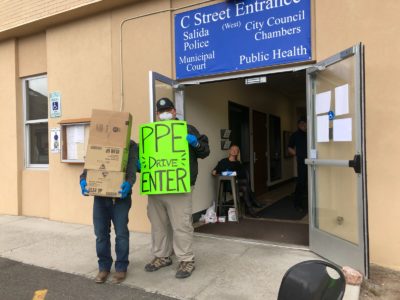The biggest question facing question facing Colorado as the coronavirus pandemic known as COVID-19 grinds across the county is where and when will the peak arrive? Those who do those kind of projections, and who understand infectious disease, appear to be giving us mixed messages: some say the worse may be yet to come, others that we may already be at the peak.

Heart of the Rockies Regional Medical Center in full protective gear prepare to test a drive-up patient outside the triage tent at the hospital recently. Photo by Dan Smith.
Infectious disease experts have explained to us that different parts of the country are going to hit that peak at different times, based upon the rates of infection in those areas, and what steps are being taken to slow the spread of the virus. Only 11 days ago, epidemiologists were projecting that Colorado’s peak would fall today — April 17.
Only 11 days ago, it was still unimaginable that yesterday the global cases of COVID-19 would pass 2.1 million, or that 145,000 people around the world would already have died from this virus.
As hospitalizations climb, the daily death rate rises, and the pandemic surge continues its steep rise, the Surgeon General of the United States warned us to “brace for our Pearl Harbor moment.” Here in Colorado that surge meant that the state projected it would need 8,554 hospital beds. Here’s the problem: the state only has 4,851 hospital beds.
As of 4 p.m. Thursday, April 16, the official Colorado COVID-19 Data tracking source Provides these Colorado statistics on COVID-19:
Total positive cases 8,675
Hospitalized 1,693
Counties 56
People tested** 41,830
Deaths 374
Outbreaks 93
The numbers above are most surely under counted, and not just because there is a 24-hour delay in results. What should be noted in the statistics for everything from total positive cases to number of counties impacted, are two realities that impact the results:
1. There is a lag in reporting test results because of the variety of labs involved, including private labs and out-of-state labs; according to their own state laws they are not required to report results to the states where the positive cases have occurred. For instance, the state’s data totals report that Chaffee County has only 35 confirmed positive COVID-19 cases, while Chaffee County itself is reporting as of this morning, that it has 56 cases — many of the test results for Columbine Manor coming from labs in Texas.
2. The availability of coronavirus testing is still extremely limited in Colorado: meaning that even if you think you have it, or have been exposed, your ability to get a test to confirm that is low.

Personal Protective Equipment Drive with Emergency Manager Richard Atkins, Director of Public Health Andrea Carlstrom and Special Projects Coordinator Mike Orrill.
According to The Institute for Health Metrics and Evaluation (IHME), which has been projecting case peaks, it added a data source for Colorado in the past couple of weeks, because it was seeing reporting inconsistencies in our previous data source. The new data source is the daily death data reported through Colorado’s Department of Public Health and Environment website. For each date of updated COVID-19 data the state provides a full time series of daily deaths reported, but the same challenge of lags in reporting remains. Colorado has ranked seventh (behind Massachusetts, New York, Alabama, Georgia, Alaska and Tennessee) in hospitalizations to death ratios; standing at 6.09.
Earlier this month the state was seeing 17 deaths per day from COVID-19 (new statistics aren’t yet available to compare). Some projections said that at the peak of the pandemic, deaths were projected to peak one day after peak resource use, on April 18. At this point, the people who do these sorts of projections originally estimated that 85 Coloradans would be dying each day from the coronavirus. As of April 13, the U.S. was projected to see 2,150 COVID-19 deaths a day. By August 4, it projected, the U.S. will see 68,841 COVID-19 deaths, which is below the initial alarming warning from the president’s COVID-19 task force before so many states initiated strict, stay-at-home orders.
But other measurements, by source such as this analysis from the University of Washington’s Institute for Health Metrics and Evaluation in Seattle, created to forecast hospital demand and death rates, show that the dates by which the death rates will fall significantly is still ahead of us. Researchers are beginning to revise projections for the peak outbreak of COVID-19 by state, because state’s social distancing and stay-at-home efforts have been working; flattening the curve and spreading out the onset of the virus allowing time for our hospitals and health care systems to prepare. According to this model, the date by which Colorado’s death rate will fall below .03 per million is between June 12 to June 26. Only time will tell if this is true or not.
Eleven days ago, our minds could not quite comprehend that as of this morning, the U.S. cases would top 872,000, and confirmed deaths would be approaching 35,000, more than triple the recorded deaths as of just of April 6. The U.S. death toll from COVID-19 is already more than three times the death total from 911 and Hurricane Katrina combined. According to The New York Times, with no uniform standard for reporting deaths, and some states and counties backtracking on counting the dead, the actual count of deaths from COVID-19 is most likely much higher than the official record.
It is an acknowledged fact that the U.S. economy really can’t open without the availability of widespread testing.
″Regular testing on a global scale, across all industries, would both help keep people safe and help get the economy back up and running,” Amazon CEO Jeff Bezos told CNBC yesterday. “For this to work, we as a society would need vastly more testing capacity than is currently available.”
Consumer confidence that this economy and our normal lives can get back to normal is dependent upon testing. But there is no national strategy for nationwide testing. Instead, yesterday President Donald Trump said that the states are going to have to develop their own testing capacity. It raises the question – if you live in a state that sets up sound testing protocol, where by June your life begins to feel normal again, and you have a family wedding in a state like Nebraska or South Dakota where not even stay-at-home orders have been required — do you attend?
https://www.outtherecolorado.com/projection-estimates-85-deaths-per-day-during-covid-19-peak-in-colorado/?utm_source=Master&utm_campaign=84f8b44ef7-EMAIL_CAMPAIGN_2018_08_08_02_49_COPY_01&utm_medium=email&utm_term=0_b88b5f678d-84f8b44ef7-173873141







Recent Comments